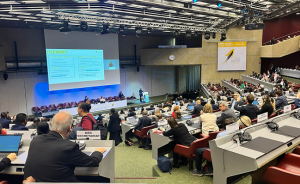International Pollutants Elimination Network (IPEN) advocates from around the world at the Fifth Conference of the Parties (COP5) of the Minamata Convention on Mercury believe that the outcomes of the international summit that held from Monday, October 30 to Friday, November 3, 2023, have been a mix of disappointing decisions with positive progress on some issues.

Among the items where they feel the COP5 fell short was in adopting a weak standard for mercury in waste and allowing blanket exemptions even for this weak standard that could result in undeclared shipments of toxic mercury-tainted waste being exported from wealthy regions to low- and middle-income countries.
The COP, they noted, also failed to adopt a health-protective ban on any level of mercury in cosmetics, despite evidence showing that products such as mercury-tainted skin-whitening creams are still widely sold.
The IPEN delegation welcomed decisions calling on Parties to report on their efforts to phase-down or phase-out dental mercury (used in dental amalgam) and the adoption of a historic resolution calling for inclusion of Indigenous Peoples in the negotiations.
“Since the mercury treaty was adopted 10 years ago, much progress has been accomplished with the support of all stakeholders. At COP5, several important decisions have been made which provide a good basis for the next 10 years,” said Yuyun Ismawati, Senior Advisor of Nexus3 Foundation, IPEN lead for ASM/mining. “Soon, we would like to see strong actions by parties to end the mercury trade globally, amend the ‘use allowed’ for ASGM under Article 2, and intensify health-related activities to address mercury poisoning.”
IPEN welcome the forthcoming cooperation and collaboration between the Minamata Convention Secretariat and the Montreal-Kunming Global Biodiversity Framework, especially to achieve Target 7, which will provide a new avenue to address the urgent issue of contaminated sites.
In defining a level for waste contaminated with mercury (“mercury waste”), the COP debated over three proposed thresholds: 10 mg/kg, 15 mg/kg, or 25 mg/kg. IPEN supports 10 mg/kg as the most protective option and notes that an even lower, more protective standard is used in some regions (for example, Switzerland uses a level of 5 mg/kg to define mercury waste). The COP5 decision to adopt 15 mg/kg fails to provide adequate health and environmental protections, but even more alarming, the COP adopted a blanket exemption to this standard.
This would allow Parties to opt out of using any threshold level and to use incompatible methods for measuring mercury in waste, undermining transparency around mercury waste and creating grave risks for the transboundary movement of waste. As a result of this week’s decision, standards for mercury waste in an importing country may be bypassed by an exporting country, resulting in undeclared shipments of mercury waste from wealthy to developing countries.
In another setback for health protections, a proposed amendment to strengthen the limit on mercury in cosmetics (from the current allowed 1 ppm to a total ban) also failed to gain consensus. Instead, a proposal to conduct more studies delayed action on this important mercury exposure source – even though a WHO report in 2019 called for action to end mercury in cosmetics, noting that “Mercury-containing skin lightening products are hazardous to health and as a result have been banned in many countries.
Even in some countries where such products have been banned, they are still advertised and available to consumers via the Internet and other means.” The COP did adopt a proposal to phase-out cosmetics containing deliberately added mercury as a preservative by 2025.
Among the few positives for the meeting was progress on dental amalgam with parties now required under Annex A Part II to prepare and submit National Action Plan reports to the COP on their efforts to phase down or phase out dental amalgam every four years. Language adding dental amalgam to Annex A Part I for phase out by 2030 was also included but is bracketed for further consideration at COP 6.
The highlight of negotiations was a decision to elevate the engagement on Indigenous Peoples in the convention. Delegates approved a resolution calling for support for the participation of Indigenous Peoples in the fight to end mercury pollution. The resolution urges the Parties to engage Indigenous Peoples in mercury elimination efforts and notes that future negotiations should include a focus on “the needs and priorities of Indigenous Peoples, as well as local communities, with regard to the effects of mercury in their health, livelihoods, culture and knowledge, with a view to future work on identifying possible solutions.” The resolution has been described by Indigenous delegates as “a monumental achievement for Indigenous Peoples globally and the first step in truly respecting and upholding our rights.”
COP 6 in 2025 may see a far more ambitious agenda with IPEN calling for major amendments to the convention that address the core sources of global mercury pollution.
“We need to get the treaty back on track and tackle the biggest mercury pollution problem in the world – the use of mercury in small-scale gold mining. This use of mercury is the leading source of global mercury pollution, exposing millions of miners to toxic vapors, polluting waterways, contaminating fish and food supply chains. Contaminated sites from this practice number in the thousands, with more created daily,” Lee Bell, IPEN Mercury Policy Advisor, said.
“We need to amend the convention to end the global legal trade in mercury to set a non-negotiable phase-out date for mercury use in ASGM and health intervention programs for vulnerable populations suffering mercury poisoning from ASGM areas. As the convention stands, there is no end date for this practice on the horizon. We have begun the conversation with delegates from all regions about the need for these changes and have received a positive response, which we will build upon ahead of COP 6. These issues must be on the agenda, or the treaty will not be successful,” added Bell.
